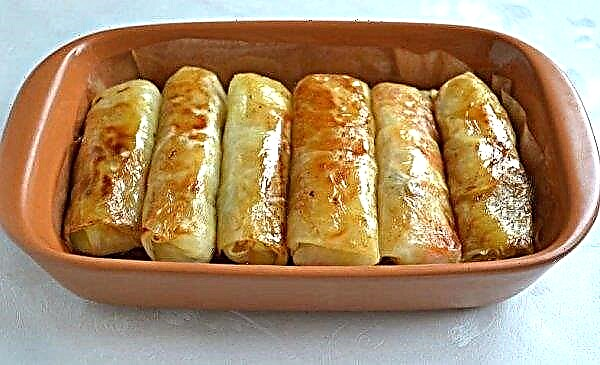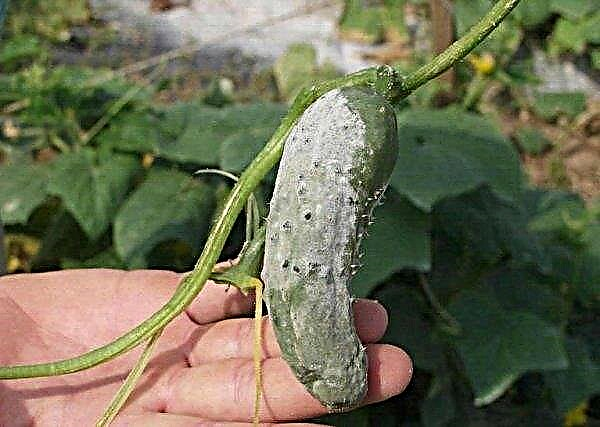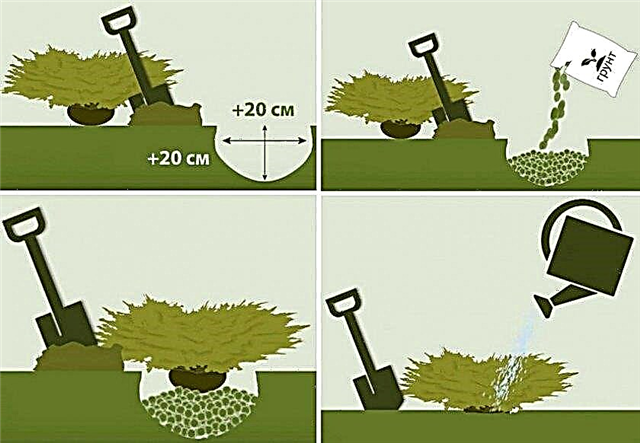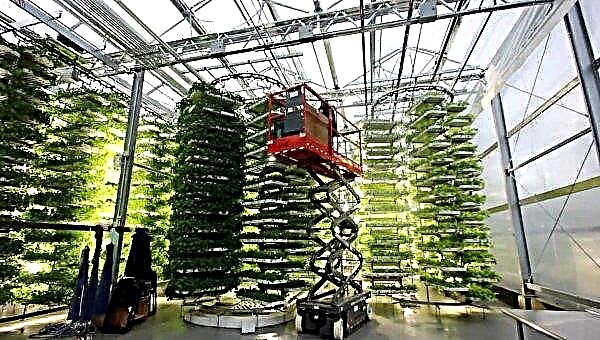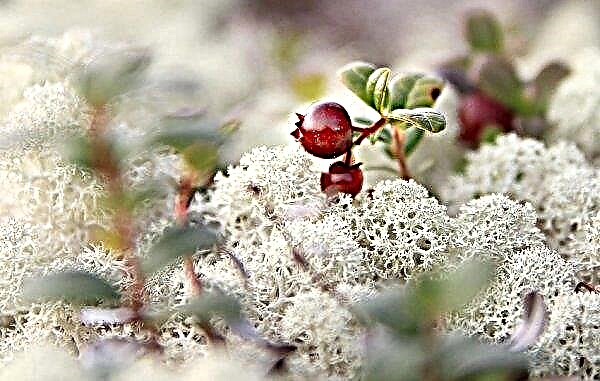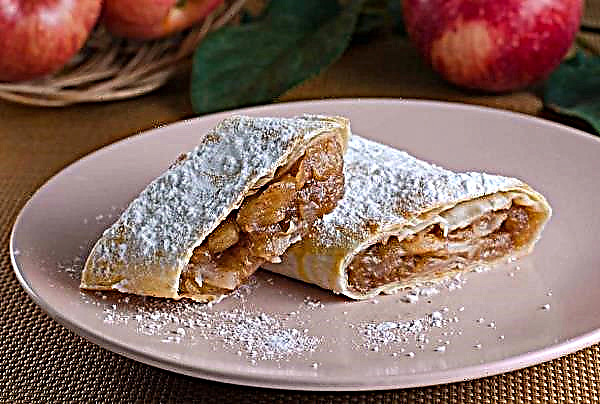A man has been breeding geese for about three thousand years, but he has not changed them much, so domestic geese, although they do not know how to fly like wild relatives, can get their own food. They also have excellent immunity and adaptability. Find out what you need to grow geese at home, how to feed them, how to keep them in summer and winter, their diseases and preventive measures.
Goose Breeding Benefits
The meat of geese has many admirers. The famous goose with apples will not leave anyone indifferent, and goose liver paste (foie gras) is considered a delicacy.
- Geese should also be bred because of these advantages:
- unpretentiousness to feed and conditions;
- fast weight gain;
- precocity
- feed saving with grazing;
- disease resistance;
- quick payback - during the summer season, you can grow a lot of geese weighing up to 6 kg with minimal feed costs.
In addition to meat and liver, other related products come from geese. Goose fat is used in cosmetics and medicine. Goose feathers have long been used for writing, and now souvenirs and shuttlecocks for badminton are being produced from them. Goose down is used for sewing pillows and down jackets.
Breeds of geese for breeding
The main breeds for breeding are not so few, there are plenty to choose from:
- Lindovskaya. It has early maturity and the fastest mass gain. Already at 5 months, birds weigh 5 kg. Unpretentious and hardy, have excellent immunity, they have good egg production and survival. To achieve good performance, you need a reservoir.
- Kholmogorsk. It is widespread and considered the most unpretentious. Gains weight quickly, but has poor egg production. Requires a pond.
- Toulouse. The largest breed of French origin. It can be grown to make foie gras. It has the highest productivity, but is demanding of conditions - it does not tolerate low temperatures and dampness.
- Tula Fighting. They have low egg production and good weight gain. They tolerate frosts and swim even in freezing water. They need grazing and a pond. The geese of this breed are good moms.
- Danish Legart. Consumes feed economically and gains weight quickly. Representatives of this breed are hardy and unpretentious, have excellent snow-white fluff. Egg production, hatchability and survival of the chicks are not the highest, but geese hatch young animals.
- Kuban. It also has high precocity and weighs 4 kg at 2 months. She also has high egg production (up to 100 eggs per year) and a high survival rate of offspring (95%). Resistant to low temperatures and many diseases.
- Large gray. Gains weight quickly and is unpretentious, the ability to hatch chicks is preserved. A moving bird that can do without ponds.







This is an incomplete list of goose breeds, but they are considered to be the most popular and profitable, have good quality meat. For growing broilers, the Toulouse, Lindov and Kholmogorsk breeds are most suitable.
In principle, any precocious meat breed that is kept in limited conditions and intensively fed is suitable for growing broiler birds.
Growing geese at home
To grow geese, you must have an appropriate room. Optimally, if there is a body of water near and the ability to organize walking on the grass.
Goslings Care
Goslings should be purchased no earlier than their 5-day age. Best if they have already reached 2-3 weeks and can spend time grazing.
If the goslings have already been bred on the farm, then for them it is necessary to do the following:
- For only hatched chicks provide a temperature of + 26 ... + 28 ° C. Drafts and dampness should be absent.
- In the first three days the detention center is illuminated around the clock, and then every day they turn off the light for 40 minutes and daily increase the period of darkness until daylight hours are 17 hours.
- First week goslings are fed every 3 hours at least 6 times a day. Gradually, the intervals increase and, when the bird grows, it eats already 3 times a day. The basis of the food is mixed feed and cereal.
- The premises where the goslings are located should be equipped with feeders and drinking bowls. Access to fresh water should always be available. The drinker must be protected with a grate so that the chick does not climb into the water, but can drink.
- On the fifth day life can be given grass, and from 7 days - walk. Two-week-old goslings can already spend their entire day walking and swim in water.

At what age do geese begin to trot
The geese begin to rush at the age of 8–10 months and reach maximum productivity by 2-3 years of life. Egg production begins in the spring and lasts approximately 5 months. The number of eggs per year depends on the breed characteristics and can range from 10 to 85 pieces in one season.
Before the laying of eggs, the goose is anxious, begins to build a nest. She becomes heavy and walks with her tail down.
How many geese live
Without slaughter, domestic geese, with good care, can survive up to 18–25 years, but in a herd of geese they can be kept for up to 4 years. A good laying hen can be left up to 6 years of age. Gusakov on a tribe with excellent characteristics can hold up to 8 years.
Did you know? Wild relatives of domestic geese are long-livers and can live up to 80 years. And the most long-lived bird is the turkey vulture, which reaches the age of 118 years.
Features of nutrition and what to feed when breeding for meat
Geese are fed wet, dry and combined feeds. You can not often give dry food, because against the background of a lack of drinking, this can cause blockage of the esophagus.
The main nutrition should consist of the following components:
- green grass and algae;
- vegetables;
- silo;
- meat and bone meal or crushed shells;
- lactic acid products.
 Half the ration of meat geese for sale should be green mass, to which are mixed soy or sunflower meal, crushed grain.
Half the ration of meat geese for sale should be green mass, to which are mixed soy or sunflower meal, crushed grain.Basically, two methods are used for fattening meat:
- Fast. For speed gain, broiler weights are limited in movement and fed mainly with corn, oats and wheat.
- Lugovoi. This method is the most economical and requires pasture overgrown with grass.
With well-chosen nutrition, slaughter of precocious rocks can be done in 60–70 days.
Conditions for keeping geese in summer
Often, geese are fed for fattening during the summer season, since such cultivation is the most cost-effective. He does not need a house - just have a fenced area for walking or equip a canopy by the lake.
The place of residence of birds should be provided with drinking bowls, feeders and nests. Optimally, if there are areas with grass for walking and ponds. Most preferred are meadows with alfalfa, legumes and clover, but geese also eat wheat grass. But sedge and some other plants they prefer to avoid.
For each little gosling, 1 sq. M is enough. m of walking, but as they grow, needs increase, and in adult specimens they are already 15 square meters. m on the head. In the conditions of a summer residence or household, such areas are usually inaccessible and content in the enclosure with feed supply will be optimal.
A good source of green food in the form of algae, as well as shells and small fish can serve as a reservoir. However, with such a diet, it should be borne in mind that infections are often introduced along with aquatic food. Then the bird is treated with antibiotics, but over time, its body gets used to this lifestyle and ceases to need treatment. Feeding poultry with compound feeds during summer walking can be reduced up to 1 time per day (in the evening). Geese themselves come from a meadow or watering hole for evening feeding - they can remember the way home.
Feeding poultry with compound feeds during summer walking can be reduced up to 1 time per day (in the evening). Geese themselves come from a meadow or watering hole for evening feeding - they can remember the way home.
Did you know? The ability of geese to eat weeds is used in the USA on cotton plantations. These birds do not like cotton culture, but the rest of the plants consume well. A flock of 25 geese successfully cleans a field of 10 ha from unnecessary vegetation.
Gusyatnik
When keeping the bird all year round, a reliable crawler is needed, which will protect well in the cold from frost, as well as from various predators.
Construction of the crawler
The area of the poultry farm depends on the number of birds and their living conditions. Typically, a room for geese is built at the rate of 1 sq. Km. With constant grazing, which can be organized in the southern regions, it is possible to make densification of up to 2.5 individuals per 1 sq. Km. m
The best place for a gusyachnik is in an elevated place by the lake or when grazing. In the absence of this, the aviary is made an aviary for walking from a metal mesh. The construction is done on the foundation of crushed stone with concrete. Walls can be made of brick, timber, concrete blocks. They must be insulated.
At least 2 openings are made for the windows and they must face south to ensure the longest daylight hours. Make 2 holes for geese with a size of 0.5 × 0.5 m.
The floor is raised 20 cm and with a slope for more convenient cleaning of waste. For the convenience of cleaning and additional heat, the floor must be covered with litter, which may consist of straw, sawdust, sand, peat. The roof is made simple, with one or two slopes, but it is best to make it with an attic for storing hay. It must be insulated and covered with roofing materials (for example, roofing material).
The roof is made simple, with one or two slopes, but it is best to make it with an attic for storing hay. It must be insulated and covered with roofing materials (for example, roofing material).
Important! The tightness in the house causes a delay in sexual development in goslings. In addition, darkness in combination with poor lighting leads to biting in birds.
Arrangement of a caterpillar
After the completion of the construction of the crawler, it is important to properly equip it.
Bird feeders and drinkers are chosen so that you can easily care for them. For dry feed, containers of wood are installed, and for wet mixes, metal is well suited. For 1 individual, there should be 20 cm of the working surface of the drinking bowl or feeder. To save space, food containers are hung at a height of about 0.5 m.
It is also necessary to set aside a site for ash baths. They are made of wood and filled with a mixture of ash and fine clay in equal parts.
Depending on the number of geese, nests are established, taking into account that 2 females account for 1 nest. Nests are mounted in a calm, shaded area of the premises so as not to disturb the birds during hatching of goslings. Be sure to equip separate compartments for adult birds and for chicks.
It should also carry out lighting and heating in the house, take care of ventilation.
Winter geese
Geese have a fairly dense plumage, so they normally tolerate the cold period and frost. But it should be noted that the feet of birds are sensitive to cold, and they do not tolerate drafts. In order for birds to endure winter without problems, certain conditions must be observed:
In order for birds to endure winter without problems, certain conditions must be observed:
- pour litter on the track’s floor for additional heat, so that the feet do not freeze in the cold of the geese;
- it’s good to clean the snow for walking in the fresh air;
- nests should have a bottom made of wood;
- care must be taken to ensure that there are no drafts, all the cracks are closed, and the house itself is well insulated.
In the cold season, it is necessary to adjust the nutrition of geese and feed them 4 times a day. In the morning and evening, give out grain feed, and in the afternoon - wet mixers containing vegetables. Feeding from roughage (hay, tree branches), sprouted grain will be useful.
How to chop and pluck a goose
Slaughter of a bird is carried out mainly in the fall, when it gains more weight. Individuals that were left on the tribe, but have already developed themselves, are sent for meat at any time.
On the eve of the slaughter itself, selected individuals are not given food for 10-12 hours. They are left in an empty room in which there is nothing to eat. It is necessary to give salt water so that the carcass is stored longer. Before the process itself, the limbs (legs and wings) are tied with a rope.
At home, the most simple method is used - separation of the head with an ax. Then the carcass is suspended by the legs so that all the blood flows out.
After slaughter, the bird should be plucked. This process can also be done in several ways. The easiest way is to pluck dry immediately after slaughter. To facilitate the work, it is better to use a tool such as a tuner. If the carcass lies down a bit, then it will be difficult to clean it from feathers. Often the carcass is poured over with boiled water to facilitate the process, but the feathers at the same time lose their presentation. In addition, after processing with boiling water, the carcass is not stored for so long.
If the carcass lies down a bit, then it will be difficult to clean it from feathers. Often the carcass is poured over with boiled water to facilitate the process, but the feathers at the same time lose their presentation. In addition, after processing with boiling water, the carcass is not stored for so long.
Important! Slaughter of meat breeds is carried out on 60–75 days of their life. But if you miss this moment, then you need to wait until 125–140 days, because in this time period the feathers will begin to change and they will lose weight, and the meat will lose its taste.
At the very end of the plucking process, the carcass must be scorched by fire to get rid of the small remains of feathers. Tweezers are sometimes used to stretch out small feathers.
Breeding geese as a business
Check out more

Near it should be a reservoir and a couple of hectares of land unsuitable for arable land. In the absence of a natural reservoir, an artificial pond should be made.
For such an activity, you will need to register as an entrepreneur and collect a package of permits from the sanitary-epidemiological station, veterinary service, and firefighters. You should familiarize yourself with all the requirements for the track carrier and products even before starting a business and investing, so that then there are no obstacles to sales.
Important! Rospotrebnadzor is prohibited from setting up a goose farm in settlements and using ponds near the residential sector to keep geese, as these birds are too noisy and aggressive.
Common Diseases
Geese are susceptible to diseases that waterfowl suffer. The most common diseases are as follows:
The most common diseases are as follows:
- Coccidiosis. This disease often affects small goslings. It manifests itself in the form of diarrhea, which causes dehydration, as well as exhaustion of the body. Renal coccidiosis affects the canals of the kidneys - in this case, the diseased individuals lose their activity and appetite, sit up with a dry tongue, which also leads to severe exhaustion. Coccidiostatics (Baycox) and sulfa drugs are used for treatment.
- Pasteurellosis. This dangerous disease quickly affects the bird and often leads to its death. In this case, the crowser is quarantined and the whole sick bird is slaughtered. Treatment is with antibiotics and sulfonamides.
- Paratyphoid. In adults, the disease can go away without any symptoms, but goslings do not tolerate paratyphoid easily. Severe diarrhea, conjunctivitis, exhaustion, respiratory failure appear, chicks begin to limp. Fatal outcome occurs in 3-4 days. Paratyphoid is treated with antibiotics such as tetracycline and nitrofuran, but treatment does not in all cases bring results.
- Helminthiasis. Geese can become infected with trematodes, cestodes, and nematodes. They are treated with anthelmintics and Ivermectin.
At low temperatures and drafts, birds can get viral diseases that cause inflammation in the frontal sinuses and sinusitis. Antibiotics are used for treatment.
Non-infectious diseases of geese include hypovitaminosis, which arise due to a lack of essential vitamins and minerals.
Disease prevention
Instead of treating the disease, it is better to prevent it in advance - especially since some infectious diseases can cause mass mortality of the bird. Experts recommend taking the following preventive measures against various diseases:
Experts recommend taking the following preventive measures against various diseases:
- Observe sanitary and hygienic standards in the house - such as maintaining cleanliness, disinfecting poultry rooms, nests, and all equipment. Replace litter regularly.
- Make sure that there are no excessive humidity and drafts in the gooseneck.
- Regularly clean and disinfect walking areas.
- Conduct sanitary and epidemiological control of reservoirs.
- Carry out the necessary vaccination.
- Keep young chicks separate from adults.
- Regularly carry out deworming against parasites.
- Include greens and succulent feed, as well as the necessary complex of vitamins and minerals in the diet.
- Balance the nutrition of poultry; ensure that the feed is of high quality and fresh.
- To prevent the occurrence of infection once a month during the warm period, add coccidiostatics to the goose in feed.
- If serious infectious diseases are detected, transfer diseased individuals to quarantine. The same thing is with the suspected presence of the disease. Too affected by the disease, birds must be slaughtered. Be sure to contact the veterinary service.
Did you know? Owners of geese often complain about the noise of these birds, but it was this quality that once saved Rome. In the historical work of the ancient historian Titus Livius, “Stories from the founding of the city,” it is described how in the 5th century BC the Gauls tried to capture the Capitol fortress at night, but the geese noticed them and made a noise and woke up the defenders of the fortress.
So, the maintenance of geese is a troublesome business, but it pays off, especially if there is a pond nearby or a territory for grazing. Seriously getting down to business, you can create a thriving business from scratch.


